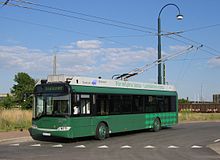Electrically powered spacecraft[edit]
Electric power has a long history of use in spacecraft.[68][69] The power sources used for spacecraft are batteries, solar panels and nuclear power. Current methods of propelling a spacecraft with electricity include the arcjet rocket, the electrostatic ion thruster, the Hall-effect thruster, and Field Emission Electric Propulsion.
Energy and motors[edit]
Most large electric transport systems are powered by stationary sources of electricity that are directly connected to the vehicles through wires. Electric traction allows the use of regenerative braking, in which the motors are used as brakes and become generators that transform the motion of, usually, a train into electrical power that is then fed back into the lines. This system is particularly advantageous in mountainous operations, as descending vehicles can produce a large portion of the power required for those ascending. This regenerative system is only viable if the system is large enough to utilise the power generated by descending vehicles.
In the systems above, motion is provided by a rotary electric motor. However, it is possible to "unroll" the motor to drive directly against a special matched track. These linear motors are used in maglev trains which float above the rails supported by magnetic levitation. This allows for almost no rolling resistance of the vehicle and no mechanical wear and tear of the train or track. In addition to the high-performance control systems needed, switching and curving of the tracks becomes difficult with linear motors, which to date has restricted their operations to high-speed point to point services.
Records[edit]
- Electric Land Speed Record 353 mph (568 km/h).[70]
- Electric Car Distance Record 1,725 miles (2,776 km) in 24 hours by Bjørn Nyland.[71]
- Greatest distance by electric vehicle, single charge 999.5 miles (1,608.5 km).[72]
- Electric Motorcycle: 1,070 miles (1,720 km) under 24 hours. Michel von Tell on Harley.[73]
- Electric flight: 439.5 miles (707.3 km) without charge.[74]
You received this message because you are subscribed to the Google Groups "1top-oldtattoo-1" group.
To unsubscribe from this group and stop receiving emails from it, send an email to 1top-oldtattoo-1+unsubscribe@googlegroups.com.
To view this discussion on the web visit https://groups.google.com/d/msgid/1top-oldtattoo-1/CAMm_%2Byb4tgAO-Je_SDQgfKjr6z8eRhXASK8PocR_BoBuWQkpfw%40mail.gmail.com.


No comments:
Post a Comment